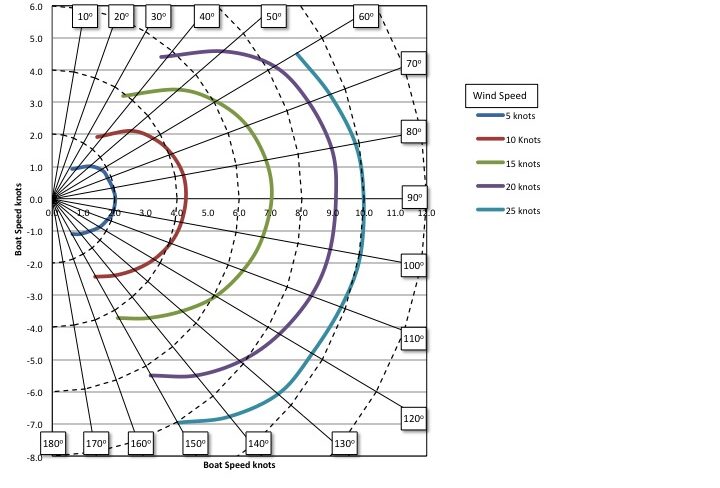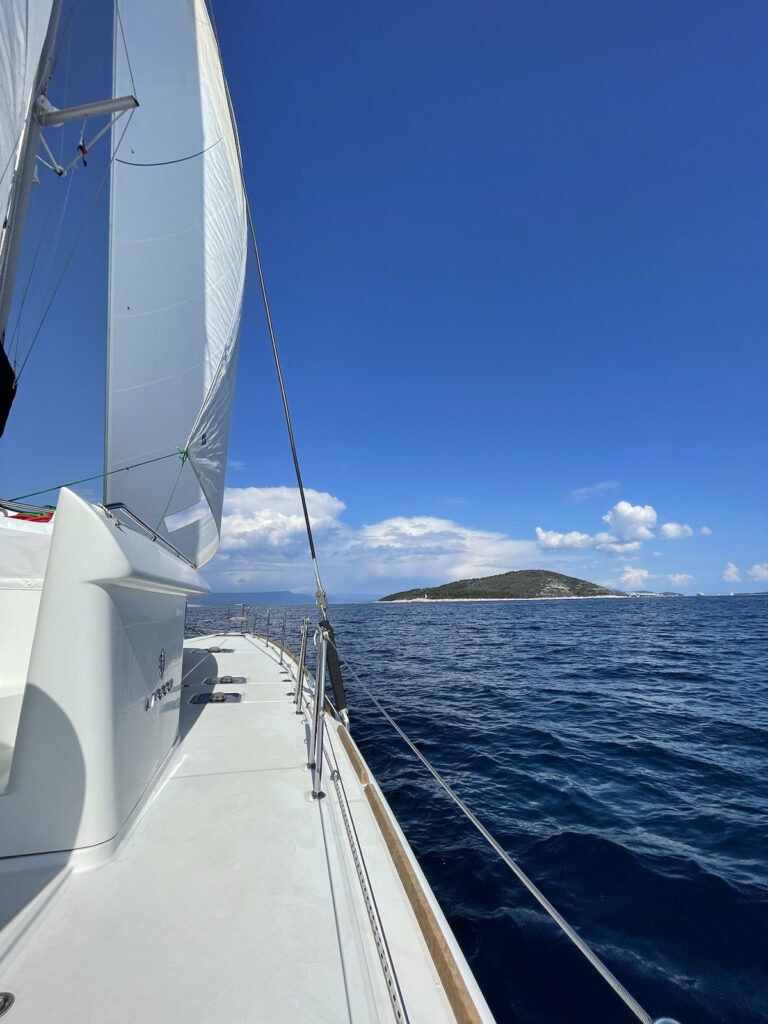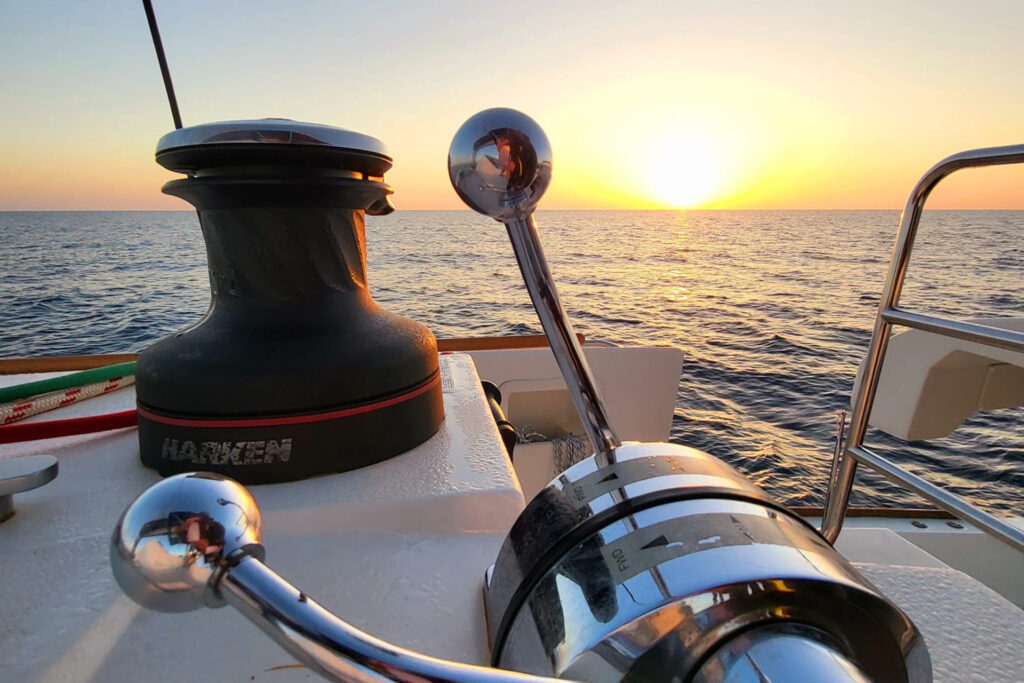Even though SUNCE can be sailed with a motor (but please only with one, see the post about motor) and sometimes there is no other option due to lack of wind or unfavorable wind direction, it is only when the humming of the engine is replaced by the sound of wind and water and the 14 tons of the ship are set in motion by the natural force of the wind that SUNCE is truly in its element.
Stabilized by the pressure in the sail, it also handles waves much more calmly under sail than under motor.
You may think that setting the sails is complicated and takes a long time? Okay, it’s not as easy as starting the engine, but with the following tips and minimal practice and, of course, the necessary sailing training, it’s much easier on SUNCE than you might think.
When to sail with SUNCE
Catamarans are often said to not be able to sail close to the wind. This is not the case for SUNCE. Although it may not be able to achieve the height of a sporty monohull boat, the design of the Lagoon 450 allows for very high courses, so SUNCE can keep up with most comfort boats even close-hauled. However, due to its two hulls, it sails much more comfortably and relaxed.
Sailing downwind is only possible to a limited extent with a catamaran without a spinnaker, and SUNCE is no exception. But if you’re not in a hurry, it’s also possible to sail downwind with just the foresail without the main in a relaxed manner.
When it comes to speed, SUNCE, like any catamaran, loves reaching. True wind at 90° with more than 12 knots true wind, that’s its sweet spot.

The diagram above shows the relationship between wind direction and wind speed.
This is custom heading element
For someone who is used to sailing on a monohull boat and is only familiar with roller sails, they may be surprised when looking at the sail plan of SUNCE. While unfurling the headsail may seem easy enough, the mainsail may seem a bit daunting. But with a few tips, setting the mainsail can also be done quickly and safely, especially with the help of SUNCE’s powerful motor winch.
Here are the steps for setting the sails:
- Check wind speed and direction. From 15 knots true wind, at least one reef must be used, so it saves a lot of work if you know this beforehand and only set the sail to the corresponding reef. The table on the left shows which reef should be used for which wind speed. If you’re not familiar with reefing a battened mainsail, there will be a post about it further down, which you can read beforehand.
- If available, have two people stationed on port and starboard to watch the sail and battens. If there are not enough people available, one person can also do this task alone.
- One person takes over the large motor winch, which is operated with foot switches. Both flaps of the foot switches must be opened. One switch is for slow speed and the other for fast speed.
- One person takes over the traveler lines, which should be hanging on the railing at the back of the flybridge, as well as the mainsail sheet. Before setting the mainsail, both traveler lines and the mainsail sheet must be opened and free. It’s best to throw the lines down into the cockpit so they don’t get tangled. This task can also be taken over by one of the people who are watching the sail, as these lines are only used before and after setting the sail.
- Another person with steering experience takes over the helm and focuses solely on the course and surroundings.
- After all positions have been assigned, preparations begin: – Start both engines, ahead at low speed of 2-3 knots – If not already done, open the boom cover, lower the lazy jacks on both sides so that the cover is open wide and the battens don’t get caught as easily. – Ease the thin downhaul line of the mainsail (on the cleat on starboard near the large winch) and preferably throw it into the aft cockpit.
- At this point, turn the boat precisely into the wind. Unlike a roller mainsail, a battened mainsail must always be set exactly into the wind, otherwise the battens will get caught in the lazy jack lines (the lines that hold the sailcloth pockets up on the boom). In calm seas and with constant, not too strong winds, the autopilot can also assist with this step. However, the helmsman should always pay attention to the surroundings and course, as you can quickly approach an island while focusing on the sails or rigging a line.
- Now, it is absolutely essential to release the main halyard line from the cleat. If this is forgotten, it will tear and it will be unnecessarily difficult to hoist the sail later on.
- Then, open the cleats for the main sheet and traveler so that the boom can rise. If this is forgotten, the sail will not be able to be hoisted all the way up, no matter how hard the electric winch works. Since the boat is facing directly into the wind, the boom will not move from its central position even with the cleats open. If it does move, immediately report it to the helmsman.
- Only now, wrap the main halyard line around the electric winch with 4 turns. Since high forces are necessary here, it should really be 4 turns. Pay attention to the direction of the winch when wrapping the line 😉
- With the command “Hoist mainsail,” use the high speed of the winch to hoist the mainsail. The two sail observers should make sure that the boom stays in the center and that no batten gets caught in the lazy jack lines. If this does happen, immediately lower the halyard line a bit and turn the boat directly into the wind again.
- Ideally, the person in charge of the traveler should also watch the reefing lines to make sure they are running freely. The reefing lines should be untangled before setting the sail to avoid any problems while hoisting the sail.
- Once the sail battens have passed the lazy jack lines and the sail is at the top, switch the winch to slow speed using the second foot switch and continue to hoist the sail slowly. One of the sail observers should check the tension of the luff of the mainsail. It should be tight enough that you can press it with your thumb without it wrinkling on its own.
- Close the cleat for the main halyard line and stow the line in the line compartment in the cockpit (do not tie it, as it may need to be retrieved quickly in case of an emergency).
- Then, close the cleats for the traveler and tighten or ease the main sheet according to the wind strength (less wind, more slack; more wind, tighter).
- Once the main sail is set, the headsail must be unfurled.
- To do this, release the sheets and throw them into the back cockpit. Wrap the necessary sheet for the course in three turns on the appropriate winch (there is only one manual winch on the port side).
- One person takes over the sheet for the course, one person takes the reef line, and the helmsman continues to steer the course.
- Release the reef line for the headsail, but always keep tension on it.
- The helmsman now sets a course slightly into the wind, without putting too much pressure on the sail.
- Use the course sheet to unfurl the headsail, keeping minimal resistance on the reef line.
- The wind will likely turn the sail completely out, but if not, use the sheet to help it along.
- Once the headsail is unfurled (or at the marked point on the sail), the process of setting the sail is complete.
- Now, the planned course can be set and the sheets and traveler can be adjusted accordingly. More on setting below under Sailing.
- IMPORTANT: Now, put the RPM of both engines in neutral, and only then turn off both engines and turn off the ignition for both engines until the display is completely off. If the ignition is not turned off, the fans in the engine room will continue to run, which not only creates a loud noise inside the boat and in the back cockpit, but also consumes a lot of electricity.
- After stopping the engines, the gear levers should be put into reverse, which will block the propellers and stop their noise. Even though SUNCE (for safety reasons) does not have folding propellers, the boat will not be slower with a blocked shaft, but it will be quieter.


